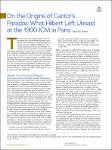Item Infomation
Full metadata record
| DC Field | Value | Language |
|---|---|---|
| dc.contributor.author | David E., Rowe | - |
| dc.date.accessioned | 2023-04-04T08:06:09Z | - |
| dc.date.available | 2023-04-04T08:06:09Z | - |
| dc.date.issued | 2023 | - |
| dc.identifier.uri | https://link.springer.com/article/10.1007/s00283-022-10259-x | - |
| dc.identifier.uri | https://dlib.phenikaa-uni.edu.vn/handle/PNK/7500 | - |
| dc.description | CC BY | vi |
| dc.description.abstract | The first two of the twenty-three unsolved problems that David Hilbert famously proposed at the 1900 International Congress of Mathematicians (ICM) in 1900 dealt with issues associated with the real number continuum. The first problem concerned Cantor’s continuum hypothesis, whereas the second dealt with Hilbert’s attempt to establish the existence of the continuum by proving the consistency of his axioms for characterizing its properties. Few have noted, however, that Hilbert himself linked the larger goals of Cantor’s theory of transfinite arithmetic with those of his own program for axiomatization. | vi |
| dc.language.iso | en | vi |
| dc.publisher | Springer | vi |
| dc.subject | Congress of Mathematicians | vi |
| dc.subject | Cantor’s continuum hypothesis | vi |
| dc.title | On the Origins of Cantor’s Paradox: What Hilbert Left Unsaid at the 1900 ICM in Paris | vi |
| dc.type | Book | vi |
| Appears in Collections | ||
| OER - Khoa học Tự nhiên | ||
Files in This Item:

